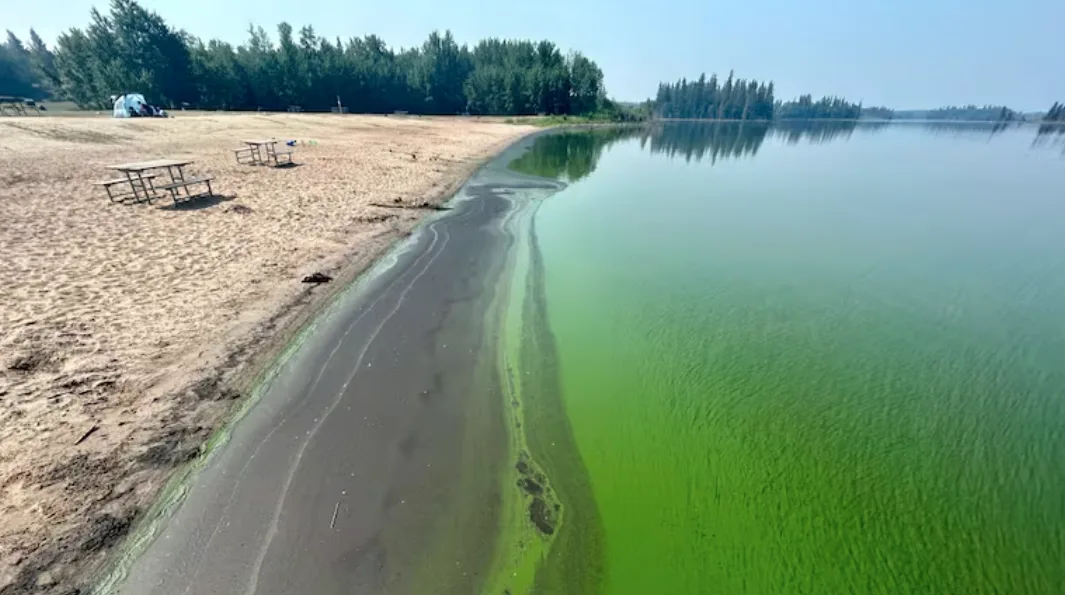
20 blue-green algae advisories issued for Alberta lakes this summer
Albertans are being reminded to watch out for blue-green algae as they visit lakes this summer, even though the province has yet to experience a prolonged heatwave which people often associate with the potentially toxic blooms.
Alberta Health Services has issued 20 advisories for lakes since the end of May.
Blue-green algae, or cyanobacteria, occurs naturally and can look like grass clippings, powder, scum or fuzz floating in the water. While it can be blue-green in colour it can also appear brown or pinkish-red.
Some cyanobacteria blooms can produce toxins which can make animals and people sick.
The blooms thrive under certain conditions. Often people think of hot weather as driving growth, and while that is true, precipitation can also play a key role in their development, according to Rolf Vinebrooke, who studies cyanobacteria at the University of Alberta.
Runoff can carry key nutrients, including phosphorous, into the lakes, he noted.
"If you don't have very warm lakes but you do have a lot of precipitation, the phosphorus coming in off the land could actually promote growth by these guys," said Vinebrooke, a professor of biological sciences at the university.
"I think that that might actually be what's causing this one because … the temperatures haven't been exceptionally high. So this might actually just be that we've had enough runoff from the land, from rainfall, that they've got enough of that essential nutrient to start growing."
With temperatures rising this week, he expects more lakes will be impacted because the heat creates prime conditions for the blue-green algae to grow.
And Vinebrooke said the blooms could be even more intense in September given this year's weather patterns.
"So this is not going to be over in August possibly."
Stay out, experts warn
Alberta Health Services warns against swimming or wading in bodies of water where blue-green algae is present. That goes for both people and pets, who should also avoid ingesting the water.
Symptoms of contact with the toxins include skin irritation, rash, sore throat, swollen lips, and red eyes. Ingesting contaminated water can lead to fever, headache, nausea, vomiting, diarrhea, muscle or joint pain and in rare cases liver damage.
"I want to emphasize that [liver damage] is rare but it's most important to avoid that situation if at all possible," said Dr. Kathryn Koliaska, a medical officer of health with Alberta Health Services.
Children are at higher risk if exposed to blue-green algae, according to Koliaska.
"Kids are smaller so it's easier for them to become sick from the same amount of exposure," she said.
"Plus when kids are out and about and playing in the water and swimming it may be easier for them to swallow some of that water. So pay special attention to kids."
People should never drink or cook with untreated water from any recreational body of water and boiling water will not remove cyanobacteria toxins, according to AHS.
Koliaska suggests people check the AHS website for advisories before heading to a lake, watch for posted signs, and inspect the water for any signs of the algae.
If contact occurs, rinse off right away, watch for symptoms and get medical help if needed, she advised.
When it comes to consuming fish caught in contaminated lakes, Koliaska said cooked fillets are generally considered safe to consume, but she advises against eating any of the trimmings or feeding them to pets.
Death among people due to exposure is rare, worldwide. But according to the government of Canada, many more animal deaths have been reported after they drink contaminated water or lick algae either off their fur or paws or when it has been washed up on shore.
"They'll drink the water unknowingly. And there are toxins produced by blue-green algae that target the liver and or the nervous system. And there are recorded pet deaths caused by blue-green algae around the world probably every year," said Vinebrooke.
Toxins can still be present after the obvious signs of blue-green algae disappear from the surface of a lake, according to Vinebrooke.
This article, written by Jennifer Lee, was originally published for CBC News.